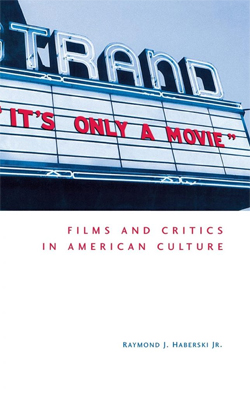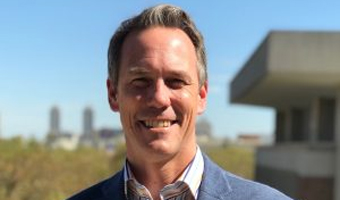Ohio University alum Raymond Haberski Jr. is Professor of History, Director of American Studies, and Director of the Institute for American Thought at Indiana University–Purdue University Indianapolis (IUPUI).
During the 2008–2009 academic year he held the Fulbright Danish Distinguished Chair in American Studies. Haberski helped found the Society for U.S. Intellectual History and remains involved in its management today.
Haberski earned a Ph.D. in History, under the direction of Dr. Charles Alexander, and a Contemporary History Certificate from the College of Arts & Sciences Ohio University in 1999.
- Connect with Haberski on LinkedIn.
His academic interests are diverse, including U.S. intellectual history, American studies, American cultural history, American religious history, history of movie culture, civil religion, and American Catholic history.
 Among Haberski’s publications are It’s Only a Movie: Films and Critics in American Culture (2001), Freedom to Offend: How New York Remade Movie Culture (2007), The Miracle Case: Film Censorship and the Supreme Court (2008), God and War: American Civil Religion Since 1945 (2012), and Voice of Empathy: A History of Franciscan Media in the United States (2018). His co-edited volumes include Beyond Bellah: Essays on American Civil Religion in the Twenty-First Century with Philip Goff and Rhys Williams and the upcoming American Labyrinth: Intellectual History for Complicated Times (2018) with Andrew Hartman. Haberski is currently at work on a monograph that looks at the U.S. Catholic Bishops’ 1983 pastoral letter, The Challenge of Peace, and a book project on the social history of the American blockbuster film.
Among Haberski’s publications are It’s Only a Movie: Films and Critics in American Culture (2001), Freedom to Offend: How New York Remade Movie Culture (2007), The Miracle Case: Film Censorship and the Supreme Court (2008), God and War: American Civil Religion Since 1945 (2012), and Voice of Empathy: A History of Franciscan Media in the United States (2018). His co-edited volumes include Beyond Bellah: Essays on American Civil Religion in the Twenty-First Century with Philip Goff and Rhys Williams and the upcoming American Labyrinth: Intellectual History for Complicated Times (2018) with Andrew Hartman. Haberski is currently at work on a monograph that looks at the U.S. Catholic Bishops’ 1983 pastoral letter, The Challenge of Peace, and a book project on the social history of the American blockbuster film.
The Contemporary History Institute recently touched base with Haberski to discuss his career and the impact that CHI has had on it.
You currently teach at IUPUI and act as director of the American Studies program there. What courses are you teaching? What are the features of the American Studies program and how does it approach Ph.D. training?
I have one of those funny appointments at IUPUI. I teach courses for the History Department—mostly post-1945 U.S. and a graduate seminar on U.S. history—and teach both the introductory course in American Studies for undergraduates and a course that orients first-year doctoral students toward the application of theories that are critical to contending with social problems. This Ph.D. course is an amalgam of both the CHI 6010 and 6020—frankly the whole doctoral program I built at IUPUI is based in large part on my intellectual and social experiences at CHI. I use John Gaddis’ The Landscape of History in the course and emphasize, as he used to with my cohort, that liberal arts training makes one a social critic almost beyond anything else.
Therefore, the American Studies program at IUPUI seeks to recruit, train, and deploy doctoral students to address issues with social and political significance. For example, one student is developing a way to use visual culture to map perceptions of gentrification and urban development. Another is critiquing the idea of community engagement through a combination of critical race theory and urban planning. Both of these students are working with organizations that have as their missions the challenge of making Indianapolis a more equitable place to live.
At the start of your academic career your research and writing focused on films and movie culture. How have your professional interests evolved and how did this process occur?
I still love researching and writing about movie culture. I have grown more interested in the social history of American blockbuster films or how they reflect and potentially shape broad debates in American life. But what I have also found super compelling is the way Americans debate moral issues or find ways to debate the morality of everything from movies to war. So my training in U.S. intellectual history prepared me to trace conversations around ides that are crucial to American conversations about morality. I have enjoyed thinking through the intersection of Catholicism and film censorship; civil religion and war; popular films and elite critics. I am now circling back to a topic that John Gaddis first suggested to me when I was a graduate student. He thought someone should do a study of how just war theory and the religious and moral implications of that theory influenced debates over U.S. foreign policy. He was probably thinking about this from his work on George Kennan who came to critique American nuclear weapons policy from a just war perspective.
Your upcoming book is an edited volume with Andrew Hartman that draws on the thinking of 19 influential intellectual historians. How did it come about? What role do you believe intellectual history plays today, in what the book’s subtitle terms complicated times?
 The book, American Labyrinth is a collection of essays that are written by my co-editor Andrew Hartman, me, and our fellow intellectual historians. We held a conference with contributors in Indianapolis to exchange essays and to emphasize that we wanted essays that would speak both to the expansive nature of U.S. intellectual history and to the debates that define contemporary American life. Many of the contributors, though not all, have been part of the Society for U.S. Intellectual History and consistent participants at its annual conference. A few, including Hartman and me, have been part of the society since its beginning and have written for the blog since 2008. In a way, this edited collection is a chance to give shape to the landscape of U.S. intellectual history. We argue in the introduction that “if you want to understand why people do things, if you want to understand why people get so animated about statues and symbols, if, in short, you want to understand the world, then you must understand ideas.”
The book, American Labyrinth is a collection of essays that are written by my co-editor Andrew Hartman, me, and our fellow intellectual historians. We held a conference with contributors in Indianapolis to exchange essays and to emphasize that we wanted essays that would speak both to the expansive nature of U.S. intellectual history and to the debates that define contemporary American life. Many of the contributors, though not all, have been part of the Society for U.S. Intellectual History and consistent participants at its annual conference. A few, including Hartman and me, have been part of the society since its beginning and have written for the blog since 2008. In a way, this edited collection is a chance to give shape to the landscape of U.S. intellectual history. We argue in the introduction that “if you want to understand why people do things, if you want to understand why people get so animated about statues and symbols, if, in short, you want to understand the world, then you must understand ideas.”
How did your time as a Contemporary History Institute student prepare you for a career in academia? Do you have any advice for current CHI students?
A great deal of what I have done in my career I trace directly back to CHI. I have maintained the friendships I made there and created collaborations with the people I met in the program. The idea of CHI has influenced the design and mission of S-USIH and its blog. For example, I had been among the handful of students who worked on H-Diplo in its early years and that shaped my interest in running and organizing academic interests through social media and digital platforms. I partnered with Marc Selverstone and Jeff Woods, friends and colleagues I met at CHI, on a digital history project we called TimeStreams while still students at OHIO. While we never fully realized the potential of that project, we all used the experience to help us broaden our interests and work in academia. Finally, the intellectual structure and mission of CHI was a primary inspiration for the applied doctoral program in American Studies at IUPUI.
One of the key things we were able to do at CHI was explore well beyond our fields of study. I strongly encourage current students to feed their creativity by creating projects and collaborations that build upon and bridge their interests. They have great faculty to learn from and an unusual amount of time to test new ideas. They should also connect with the diverse alumni of CHI—I’m pretty sure that I speak for many alumni by encouraging such connections.




















Comments